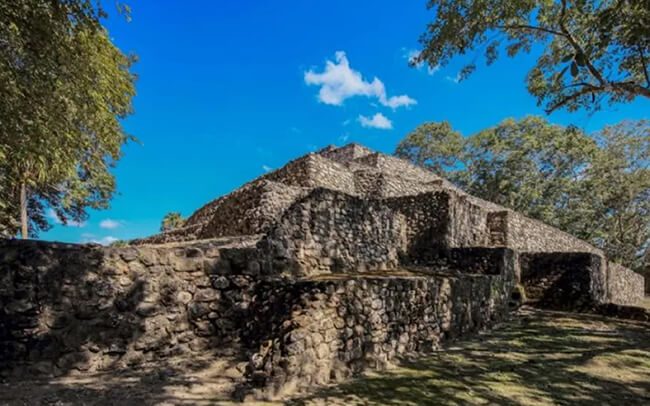
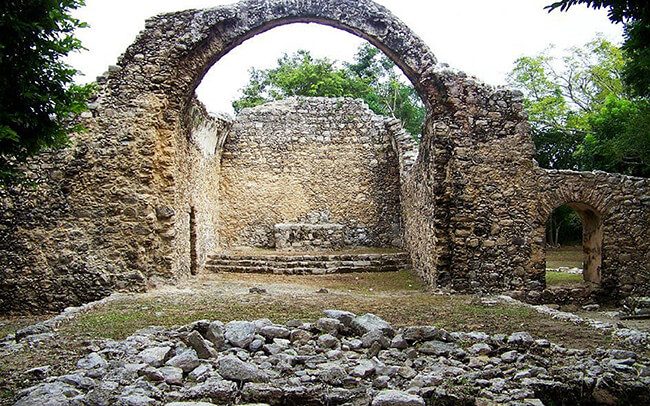
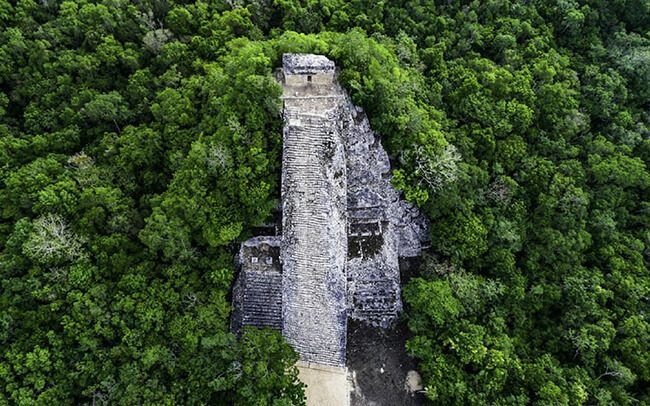
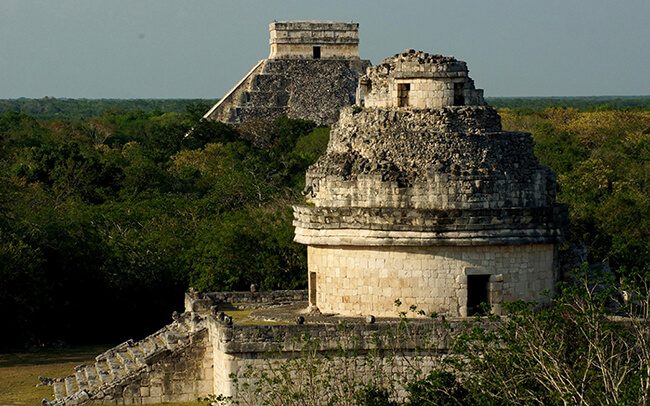
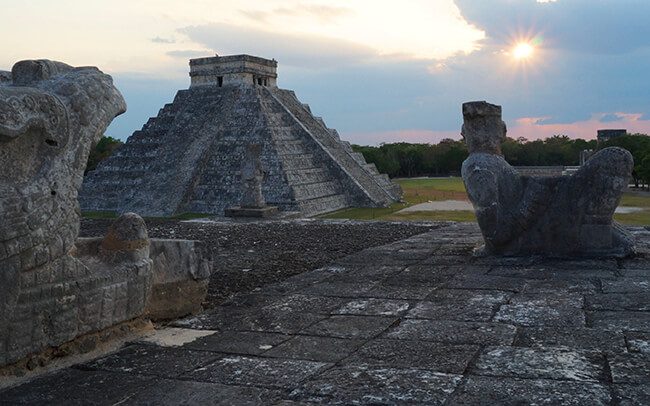
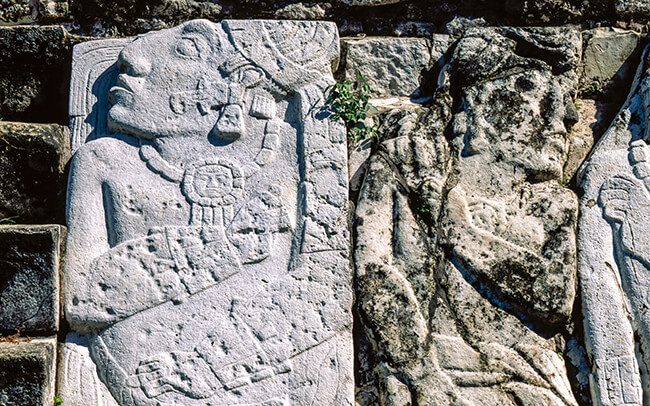
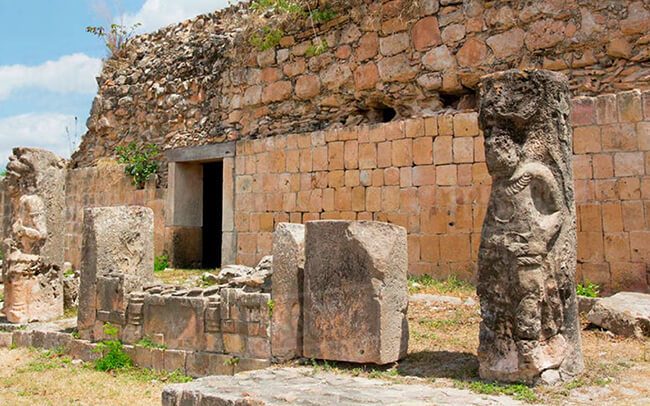
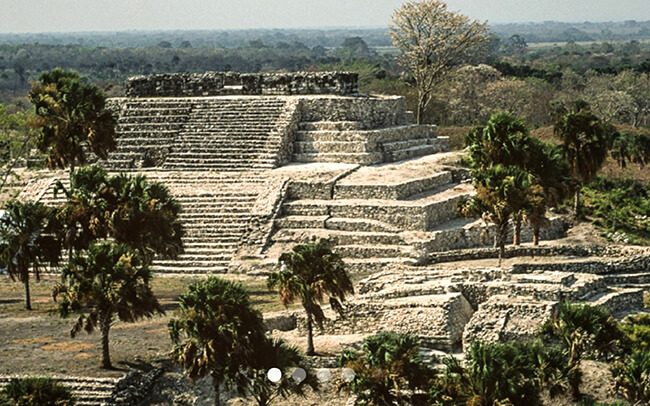
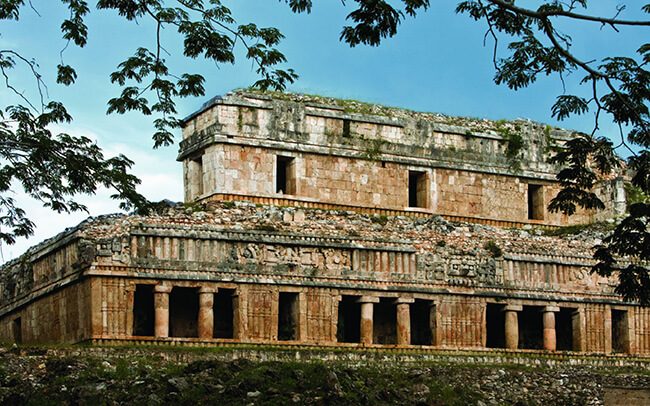
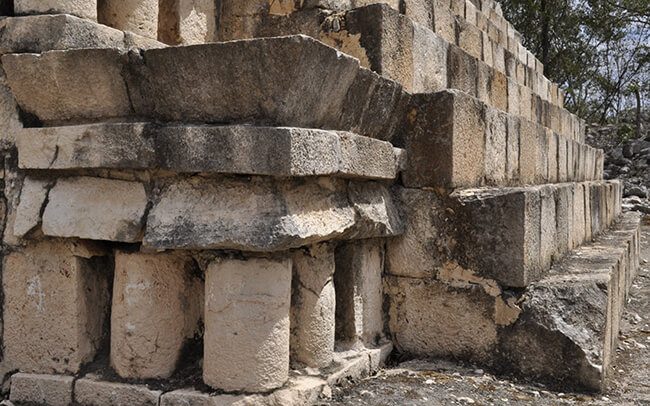
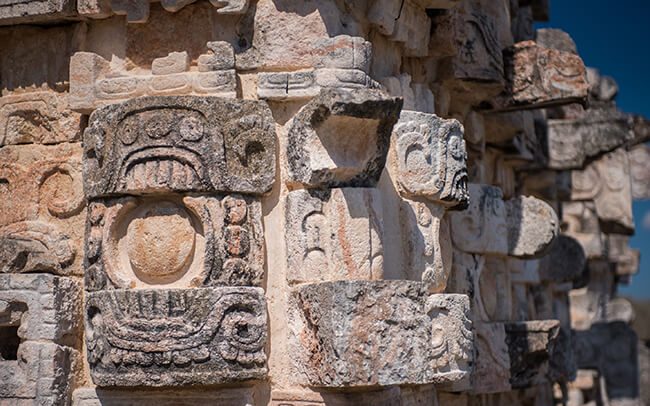
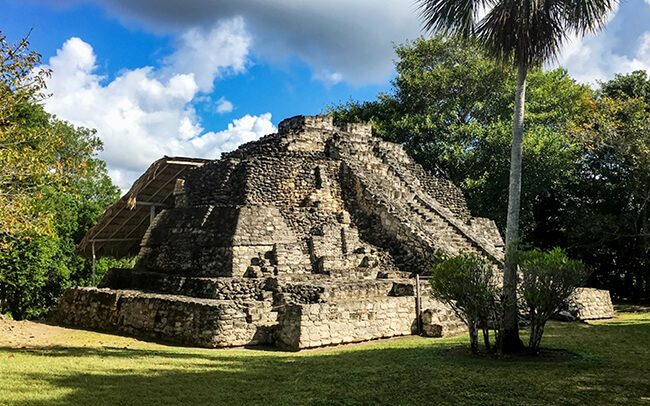
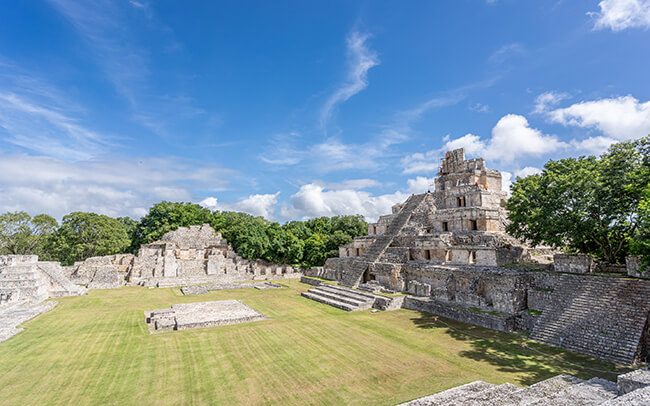
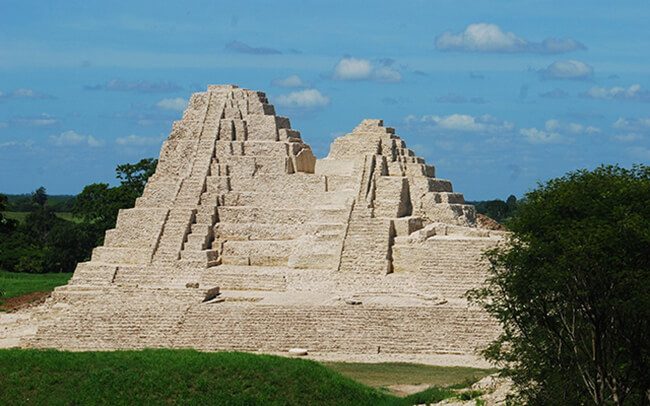
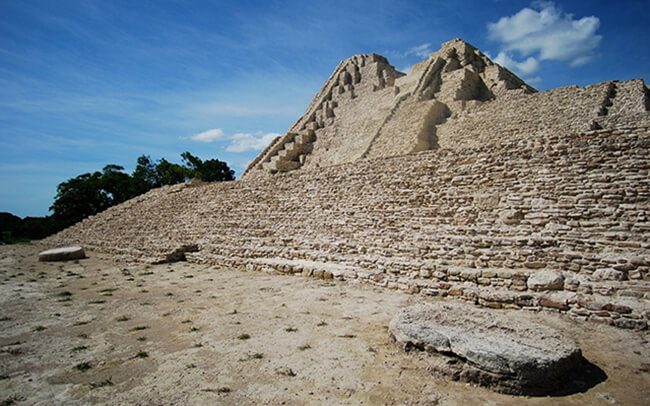

Visiting Palenque means discovering the soul of the Mayan world and understanding its rituals and beliefs. This site was inscribed on the UNESCO World Heritage List as one of the most influential Mayan cities, shaping other settlements along the Usumacinta River basin.
Palenque was home to a powerful dynasty, including the renowned King Pakal. Its peak occurred between 615 and 783 AD during the Classic Period.
Due to its strategic location, Moral-Reforma served as a trade hub and port for major Mayan cities engaged in commerce and production during the Classic Period (200-900 AD). The site features over 76 pre-Hispanic structures, carefully arranged around two open plazas.
Notable highlights include the Western Plaza Complex, bordered by 19 buildings, and the Eastern Plaza Complex, which consists of 28 structures. However, the ancient city extended far beyond this core, covering approximately 3,000 hectares with additional constructions. Its Petén-style architecture closely resembles that of Calakmul. Don’t miss the site’s museum for a deeper dive into its history.
As one of the most significant Mayan cities during the Late Classic Period (700-900 AD), Edzná’s name means “House of the Itzaes.” This name reflects its Chontal Maya origins, as the Itzaes settled in this fertile valley, constructing an advanced network of canals and water reservoirs for irrigation and drinking water.
Between 400 and 1000 AD, Edzná rose to prominence as a powerful regional capital, dominating surrounding settlements and concentrating political, economic, and religious power. Covering 17 km², the site is home to numerous monumental structures that showcase the might of its ruling elite.
Once a crucial river port, El Tigre was a natural trade route connecting the Campeche coast with the Petén region. It was inhabited from the Preclassic Period (600-300 BC) to the Protohistoric Period (c. 1557 AD).
The ceremonial center, built on a natural hill along the Candelaria River, features four main structures and several plazas. Its magnificent stucco masks, discovered in one of its substructures, are a major highlight, showcasing the city’s exceptional pottery craftsmanship and deep connection to its religious worldview.
Located in the Campeche portion of the Puuc region, Xcalmukín sits on fertile plains and translates to “Place of Good and Sunny Land” or “Window Where the Sun Enters.” This ancient city, over 1,500 years old, played a crucial role in agricultural supply chains for nearby settlements and served as a vital communication hub connecting inland areas with the Campeche Gulf Coast.
Xcalmukín was inhabited from the 5th to the 10th century AD, reaching its peak during the 8th century, when it saw its most ambitious construction efforts. The city boasts monumental palatial and residential architecture, reflecting the prosperity and influence it once held.
One of the most significant Puuc settlements, Kabah flourished during the Terminal Classic Period (750-900 AD). This period saw the construction of its East and Northwest groups, featuring distinctive Puuc-style multi-room buildings arranged around plazas and courtyards.
Kabah’s architecture is defined by intricately decorated facades, particularly the Codz Pop, a breathtaking structure adorned with cascading stone masks from floor to ceiling. This city stands as a stunning testament to the artistic mastery and architectural innovation of the ancient Maya.
Sayil, meaning “The Place of the Leafcutter Ants,” is a fascinating example of Puuc architecture. Its second level features a frieze adorned with Chaac masks, while the third level presents a smooth, undecorated frieze.
Xlapak is home to one of the best-preserved palaces of the Puuc region. Its decorative elements include intricate geometric designs, columns, and rows of Chaac masks, which highlight the site’s artistic and architectural richness.
Labná immediately impresses with its exquisite Puuc-style architecture, considered among the finest examples of the period. This settlement flourished during the Terminal Classic (800-1000 AD) and is renowned for its iconic Labná Arch, a majestic vaulted passageway that provides access to a small courtyard west of the observatory.
What makes this ancient city truly remarkable is how its inhabitants skillfully utilized the natural hills to construct its most significant architectural complexes. The site’s name, meaning “Red Stone Mounds,” reflects the striking hues of its buildings at sunset.
Uxmal is a masterpiece of Mayan architecture, renowned for its perfect symmetry and stunning design. At its peak during the Late Classic period (600-800 AD), the city housed nearly 20,000 inhabitants and served as an economic and political powerhouse.
The orientation and decoration of its structures reveal deep reverence for water, earth, the Sun, and Venus. Among its most notable constructions is the Pyramid of the Magician, an awe-inspiring temple built atop a low platform that dominates the landscape.
Also known as Maxacan or Tzat Tun Tzat, Oxkintok was one of the most monumental cities in northern Yucatán during the Mayan Classic period (400-900 AD). By the Early Classic (300-500 AD), it had become a key commercial hub, connecting trade routes between the Gulf of Mexico and Central Mexico.
The city’s pyramidal structures, palaces, and hieroglyphic monuments showcase advanced construction techniques and confirm its status as one of the dominant cities of the Puuc region. Noteworthy discoveries include anthropomorphic stone columns and elaborately carved stelae.
Once a vast and thriving metropolis, Dzibilchaltún was home to nearly 20,000 inhabitants at its peak. Its intricate network of sacbé roads connected various parts of the city and its surroundings.
With a history spanning from the Middle Preclassic to the Postclassic period (1200 BC – 1551 AD), Dzibilchaltún preserves an extraordinary legacy, featuring remains of multiple pre-Hispanic settlements and the iconic Temple of the Seven Dolls, a structure aligned with the sunrise during the equinox.
Chichén Itzá is one of the most significant cities of pre-Hispanic Mexico and has been declared a UNESCO World Heritage Site. Its name translates to “Mouth of the Well of the Itzaes,” referencing the Sacred Cenote. The city flourished during the 9th century, with its architectural complexes connected by a network of roads known as sacbés.
Its first peak occurred during the Terminal Classic period, when Puuc-style buildings were constructed. Later, between 967 and 987 AD, the Itzaes arrived and took control of the city, introducing the Maya-Toltec architectural style, a fusion of native Maya traditions with Toltec influences.
Ek’ Balam, meaning “Black Jaguar,” was a grand Maya city during the Late Classic period (600–900 AD). Its central area, home to one of the most remarkable concentrations of monuments in Yucatán, was surrounded by three defensive walls.
Inside, visitors can explore temples, palaces, plazas, a steam bath, altars, shrines, and stelae. The site’s architecture blends elements from the Petén, Chenes, Puuc, and East Coast styles. The Acropolis stands out, featuring high-relief stucco sculptures of winged figures embedded in its walls—masterpieces of Maya craftsmanship.
El Meco’s first occupation dates back to the Early Classic period, when it was a small fishing village likely linked to larger sites like Cobá. By 1200 AD, its strategic coastal location increased its importance as maritime trade and resource exploitation expanded.
The excavated area includes a ceremonial and political plaza surrounded by palatial and administrative structures. The highlight is El Castillo, the tallest building in the region. From its summit, visitors can enjoy breathtaking views of Isla Cancún.
Nestled along the eastern coast of the Yucatán Peninsula, Paamul II is part of an eco-archaeological corridor with over 300 pre-Hispanic structures, some reaching heights of more than 8 meters.
Among its most intriguing features are ancient skeletal remains, artifacts, pottery, and an underground cave running directly beneath the main pyramid. Other must-see sites include Garra del Jaguar, a partially flooded cave system; Cueva Ocho Balas, home to a temple in the East Coast style; and Cueva de las Manitas, featuring fascinating cave paintings.
Xelhá, meaning “Water Entrance” in Maya, was a vital port for the kingdom of Cobá. It experienced two major periods of prosperity. During the Early Classic period (250–600 AD), it was the region’s most prominent port, boasting beautiful palaces adorned with mural paintings.
After a period of abandonment, it resurged in the Late Postclassic period (1250–1550 AD), with new coastal settlements and the construction of various structures.
Tulum was originally known by its Maya name, Zamá. Its prime location on the Caribbean Sea enabled marine resource exploitation and control over maritime trade routes. The site is encircled by a fortified wall on its north, south, and east sides, featuring five access points and two watchtowers.
The structures visible today mainly date back to the Late Postclassic period, though evidence suggests human occupation since at least the Early Classic. One of its most iconic landmarks is El Castillo, a pyramid crowned by a temple with three entrances, adorned with serpent-shaped columns and zoomorphic masks at its corners.
The majority of Muyil’s monuments date from the Early and Late Postclassic periods (900–1550 AD), when the city played a key role in the expanding coastal trade network of the Yucatán Peninsula.
Its architecture follows the Petén style, with notable structures including El Castillo and the three platforms of the Grupo de la Entrada. During the Early Postclassic, Muyil maintained close ties with Chichén Itzá and Mayapán. Nearby, the stunning Chunyaxché Lagoon offers turquoise waters surrounded by lush vegetation and diverse wildlife, best enjoyed on a boat tour.
Chacchoben is the largest settlement in the southern Quintana Roo lake region. Its origins date back to the Late Preclassic period (300 BCE) when it was founded as a small village, strategically located near two freshwater sources—Lagoons Ocho and Chacchoben.
By the Early Classic period (250 CE), Chacchoben had evolved into a significant settlement with public structures. Its architectural style features influences from the Petén, Río Bec, and Chenes traditions.
The ancient city of Cobá developed around five lakes, which played a crucial role in its growth and survival. Archaeological evidence suggests that human settlements existed here as early as 100 BCE to 300 CE, with an economy primarily based on agriculture and hunting.
Cobá became a major economic and political hub, exerting control over nearby settlements. The city’s construction boom occurred between 800 and 1000 CE, during which an extensive road network was expanded, new buildings were erected, and trade connections with the Gulf Coast were strengthened.
Nestled within the jungle near the mesmerizing Bacalar Lagoon—also known as the “Lagoon of Seven Colors”—Ichkabal is a vast archaeological site spanning over 30 square kilometers. Its towering structures, reaching up to 46 meters in height, indicate that it was once a major political center from the earliest times.
The layout and design of its buildings suggest continuous occupation from the Late Preclassic period (400 BCE–200 CE). Ichkabal consists of six architectural groups and four water reservoirs. The Main Group features three massive platforms and a south-facing plaza enclosed by a rectangular reservoir covering one hectare.
Oxtankah is the largest and most significant city in the Bay of Chetumal. Its prime coastal location allowed for the exploitation of abundant marine resources and placed it at the heart of Quintana Roo’s ancient trade routes.
With a long history of occupation dating back to the Early Classic period (250–600 CE), this site saw the construction of its most important structures during this time. The Plazas of the Bees and the Columns became ceremonial spaces, while Buildings IV and VI, featuring Petén-style architecture, were erected.
Amid lush tropical surroundings, where howler monkeys and toucans roam freely, lies Kohunlich—one of the most extensively studied sites in southern Quintana Roo. Visitors can explore not only its public and ceremonial spaces but also its residential areas, which reflect a clear social hierarchy.
Kohunlich boasts a unique architectural style, distinct iconography, and a rich tradition of ceramic production. Founded around 200 BCE, by the end of the Early Classic period (500–600 CE), it had already become a well-established city of considerable size.
The Dzibanché-Kinichná complex comprises four monumental architectural groups: Dzibanché (the Main Group), the Central Complex (or Lamay Group), Tutil, and Kinichná. These groups served distinct functions and were interconnected by sacbés, the white limestone roads of the Maya civilization.
The site’s early architecture exhibits the Petén style, which was later replaced during the mid-Classic period (circa 600 CE) by structures featuring paired pilasters, soaring vaulted ceilings with double-tiered development, and talud-tablero (slope-and-panel) bases. These characteristics reflect a unique local style associated with the Kaan dynasty, which established its rule in Dzibanché during the Early Classic period.
Set within an unparalleled natural environment, Calakmul was the most powerful city in the Maya lowlands between 250 and 700 CE. As a regional capital, it was the chief rival of Tikal, Guatemala—a power struggle that Calakmul ultimately won.
Calakmul’s architectural style belongs to the Petén region, with five grand complexes centered around the vast Central Plaza. One of its most striking landmarks is Structure II, located to the south—the oldest pyramid in the city and one of the tallest temple bases in Mexico.